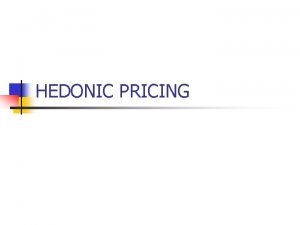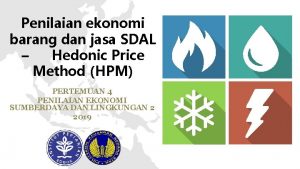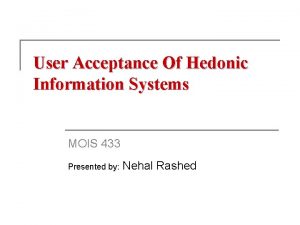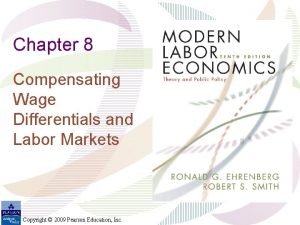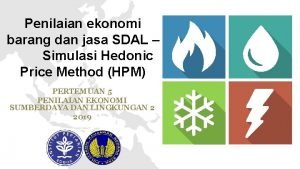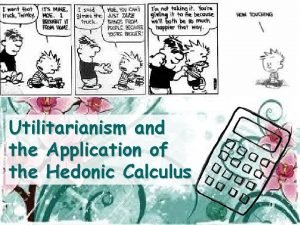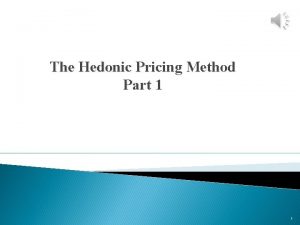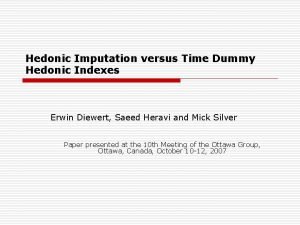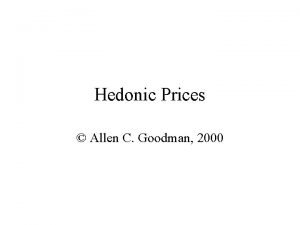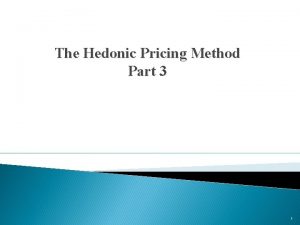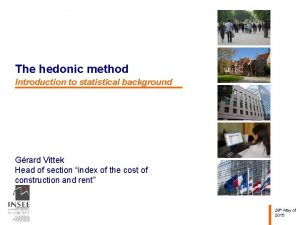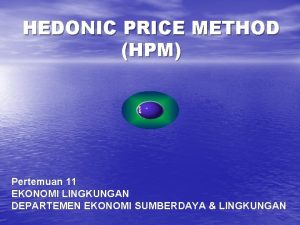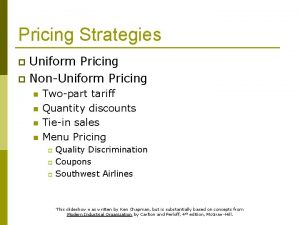HEDONIC PRICING n The hedonic pricing method is



















- Slides: 19

HEDONIC PRICING

n The hedonic pricing method is used to estimate economic values for ecosystem or environmental services that directly affect market prices. It is most commonly applied to variations in housing prices that reflect the value of local environmental attributes.

It can be used to estimate economic benefits or costs associated with: n n environmental quality, including air pollution, water pollution, or noise environmental amenities, such as aesthetic views or proximity to recreational sites

The basic premise of the hedonic pricing method n the price of a marketed good is related to its characteristics, or the services it provides. For example, the price of a car reflects the characteristics of that car—transportation, comfort, style, luxury, fuel economy, etc.

we can value the individual characteristics of a car or other good by looking at how the price people are willing to pay for it changes when the characteristics change. The hedonic pricing method is most often used to value environmental amenities that affect the price of residential properties.

Example n Hypothetical Situation: Agency staff want to measure the benefits of an open space preservation program in a region where open land is rapidly being developed.

Why Use the Hedonic Pricing Method? n n Housing prices in the area appear to be related to proximity to open space. Data on real estate transactions and open space parcels are readily available, thus making this the least expensive and least complicated approach.

Alternative Approaches: n If the open space of concern is used mainly for recreation, the travel cost method might be used. Alternatively, survey-based methods, like contingent valuation or contingent choice, might be used. However, these methods would generally be more difficult and expensive to apply.

Application of the Hedonic Pricing Method: Step 1: The first step is to collect data on residential property sales in the region for a specific time period (usually one year). The required data include: n selling prices and locations of residential properties n property characteristics that affect selling prices, such as lot size, number and size of rooms, and number of bathrooms n neighborhood characteristics that affect selling prices, such as property taxes, crime rates, and quality of schools n accessibility characteristics that affect prices, such as distances to work and shopping centers, and availability of public transportation n environmental characteristics that affect prices

Step 1 n In this case, the environmental characteristic of concern is the proximity to open space. The researcher might collect data on the amount and type of open space within a given radius of each property, and might also note whether a property is directly adjacent to open space. Often, this type of data may be obtained from computer-based GIS (geographical information systems) maps. Data on housing prices and characteristics are available from municipal offices, multiple listing services, and other sources

Step 2: n Once the data are collected and compiled, the next step is to statistically estimate a function that relates property values to the property characteristics, including the distance to open space. The resulting function measures the portion of the property price that is attributable to each characteristic. Thus, the researcher can estimate the value of preserving open space by looking at how the value of the average home changes when the amount of open space nearby changes.

How Do We Use the Results? n The results can be used to evaluate agency investments in open space preservation. For example, specific parcels may be under consideration for protection. The hedonic value function can be used to determine the benefits of preserving each parcel, which can then be compared to the cost.

Advantages of the Hedonic Pricing Method: n n n The method’s main strength is that it can be used to estimate values based on actual choices. Property markets are relatively efficient in responding to information, so can be good indications of value. Property records are typically very reliable. Data on property sales and characteristics are readily available through many sources, and can be related to other secondary data sources to obtain descriptive variables for the analysis. The method is versatile, and can be adapted to consider several possible interactions between market goods and environmental quality.

Issues and Limitations: n n n n The scope of environmental benefits that can be measured is limited to things that are related to housing prices. The method will only capture people’s willingness to pay for perceived differences in environmental attributes, and their direct consequences. Thus, if people aren’t aware of the linkages between the environmental attribute and benefits to them or their property, the value will not be reflected in home prices. The method assumes that people have the opportunity to select the combination of features they prefer, given their income. However, the housing market may be affected by outside influences, like taxes, interest rates, or other factors. The method is relatively complex to implement and interpret, requiring a high degree of statistical expertise. The results depend heavily on model specification. Large amounts of data must be gathered and manipulated. The time and expense to carry out an application depends on the availability and accessibility of data.

Contoh: n suatu rumah h didefinisikan atas karakteristik struktural Sh, karakteristik lingkungan dan lokasi Nh, dan amenitas lingkungan Ah. Ekulibrium pasar rumah dikarakteristikan dengan fungsi hedonic price yang menghubungkan harga rumah Ph dengan karakteristik, sebagai berikut: Ph= f (Sh, Nh, Ah)

Penelitian Aurelia Bengochea Morancho, “A hedonic valuation of urban green areas” n n n Pi= βo+ β 1 SIZEi + β 2 M 2 BALi + β 3 AGEi + β 4 BATHSi + β 5 GREENDISi+ β 6 D 1+ β 7 D 2+ β 8 D 3+ β 9 D 4+ ɛi Dimana: SIZEi = living area of the dwelling, in square meters. M 2 BALi = square meters of the balcony. AGEi = housing age in years. BATHSi = number of bathrooms assigning one point to every complete bathroom and 0. 5 points to those which do not have bathtub. GREENDISi = the distance from the nearest urban green area to the housing (in m) D 1 = dichotomic variable that takes a vakue of 1 when the housing is classified as “protected” (which means fiscal advantages on buying) and 0 otherwise. D 2 = dichotomic variable that takes a value of 1 if the housing has a small storeroom and 0 otherwise. D 3 = dichotomic variable that takes a value of 1 if the housing is individual (a house) and 0 otherwise ( a flat, studio, or apartment). D 4 = dichotomic variable that takes a value of 1 when the housing has an elevator and 0 otherwise.

Penelitian B. Bolitzer and N. R. Netusil, “The impact of open space on property values in Portland, Oregon” n n Harga jual rumah dapat diwakili oleh: Pi = P(Si. Qi. Gi. ONi) Dimana Pi adalah harga rumah, Si adalah vektor dari karakteristik struktural, Qi adalah vektor dari karakteristik lingkungan, Ni adalah vektor dari karakteristik daerah sekitar tempat tinggal.

Penelitian Heather A. Sander and Stephen Polasky, “The value of views and open space: Estimates from a hedonic pricing model for Ramsey County, Minnesota, USA” n n n n ln. Pi = β 0 + β 1 Si + β 2 Ni + β 3 Qi +εi dimana: Pi = Harga properti Si = Karakteristik struktural dari properti (luas lahan, jumlah kamar, usia, gaya arsitektur rumah, dll. ) Ni = Karakteristik lingkungan sekitar (tingkat kriminalitas, kepadatan penduduk, pendapatan rumah tangga, dll. ) Qi = Karakteristik lingkungan hidup ( jarak dari rumah ke danau, ruang terbuka hijau, dan pemandangan) εi = error term

 Advantages of hedonic pricing method
Advantages of hedonic pricing method Contoh hedonic price method
Contoh hedonic price method User acceptance of hedonic information systems
User acceptance of hedonic information systems Kevin t mc
Kevin t mc Allostasis
Allostasis Hedonic rating scale
Hedonic rating scale Compensating differentials
Compensating differentials Hedonic demand function adalah
Hedonic demand function adalah What is compensating differentials
What is compensating differentials Hedonic calculus scenarios
Hedonic calculus scenarios Introduction of symposium
Introduction of symposium Hình ảnh bộ gõ cơ thể búng tay
Hình ảnh bộ gõ cơ thể búng tay Bổ thể
Bổ thể Tỉ lệ cơ thể trẻ em
Tỉ lệ cơ thể trẻ em Gấu đi như thế nào
Gấu đi như thế nào Chụp phim tư thế worms-breton
Chụp phim tư thế worms-breton Bài hát chúa yêu trần thế alleluia
Bài hát chúa yêu trần thế alleluia Môn thể thao bắt đầu bằng từ chạy
Môn thể thao bắt đầu bằng từ chạy Thế nào là hệ số cao nhất
Thế nào là hệ số cao nhất
